by Bert Whyte
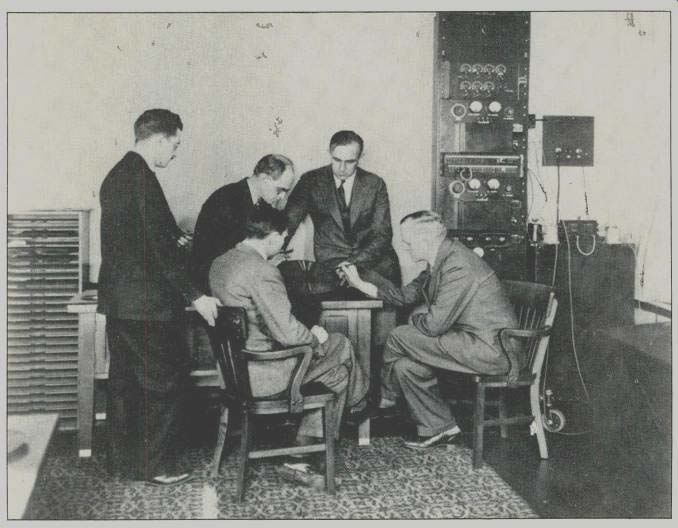
above: The Bell Labs group that developed high-fidelity recorded sound are
shown circa 1930. From the left, they are: P. B. Flanders, J. P. Maxfield,
D. G. Blattner (seated), A. C. Keller, and H. C. Harrison (seated).
The year is 1933, and President Franklin D. Roosevelt is trying to cope with the Great Depression. Those who are lucky enough to hold house and hearth together ofttimes attempt to relieve the tensions of the day by playing phonograph records. Their 12-inch records revolve at 78 rpm and are made of a shellac-based compound with an abrasive asphaltic filler that will grind the steel playback needle to the contour of the record grooves. This naturally produces noise. The phonograph pickup is a mechanical/acoustical transducer, and the steel needle linked to the transducer tracks the record with about 5 to 7 ounces of force. At best, the frequency response of the record and play back system extends from about 150 to 3,000 cycles. The sound is noisy, nasal, and constricted.
At the same time in a laboratory in Murray Hill, New Jersey, other people are playing phonograph records. Their 12-inch discs revolve at 33 1/3 rpm. The records are made of a plastic and have quiet playback surfaces, which are tracked by a magnetic moving-coil pho no cartridge at a force of 2 grams. A vacuum-tube amplifier magnifies the tiny electrical signal coming from the pickup many fold and feeds it into a loudspeaker with a multi-cellular horn tweeter and 15-inch woofer. The full-bodied sound ex tends from 40 to 12,000 cycles, and the music of the Philadelphia Orchestra con ducted by Leopold Stokowski sounds just great. In another part of the laboratory, another record is being played and its output is fed to two amplifiers and two of the big loudspeakers, because the playback is in stereophonic sound.
How can this be? Have we stumbled across a secret laboratory run by creatures from outer space? Not at all. The laboratory is operated by mortal men under the benevolent embrace of the Bell Telephone Company.
The hi-fi or audio industry as we know it today is generally considered to have come into being about 1948. At that time, much of the so-called hi-fi equipment was derived from broadcast and motion picture technology and was sold mainly in radio and electronics parts stores. However, a limited number of such items as phono cartridges, amplifiers, and loudspeakers were specifically developed for the hi-fi nuts and their fledgling market. It must be remembered that 1948 was still the era of monophonic sound, 78-rpm shellac records, and 5- to 10-watt amplifiers. It was pretty primitive stuff, especially considering the equipment Bell Labs had developed 15 years earlier. The story of the Bell Tele phone Laboratories research that led to the first high-fidelity sound and the people who developed it is truly fascinating.
Bell Labs was in a uniquely favorable position to undertake basic research in speech, hearing, music, and acoustics.
The underlying thrust for all this activity was the improvement of the quality of telephone sound and its transmission.
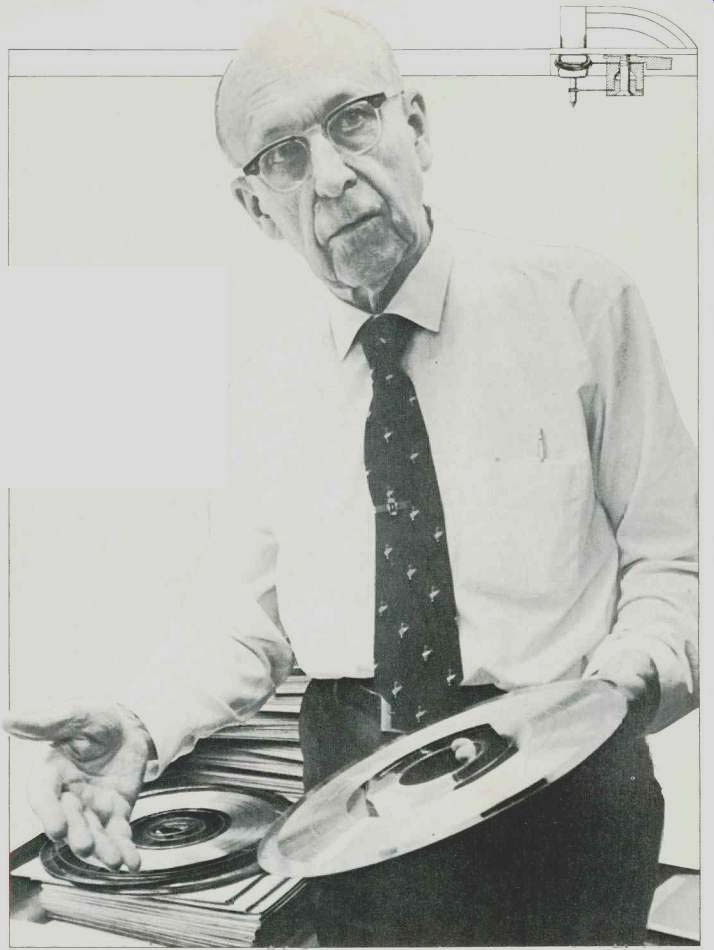
above: One must admire the talent shown by Arthur Keller and his
colleagues at Bell Labs, as well as the pioneering advances they made in
recording technology.
Considerable progress had been made in these areas during the 1920s. Bell Labs had always been interested in disc recording and reproduction, especially of speech, and felt this was a valuable adjunct in their ongoing development of telephone sound quality. The recording of music presented similar problems to the recording of speech, especially with respect to frequency response, dynamic range, and distortion content. As far back as 1916, the Western Electric Engineering Laboratory (the precursor of Bell Labs) had indicated that research directed to the improvement of disc recording and ,reproduction of music would be worthwhile.
It must be remembered that during the '20s, '30s and '40s the Bell System was a vastly successful commercial enterprise. Bell Labs had enormous technical and financial resources and attracted many brilliant scientists to its roster. Distinguished Bell Labs personnel included such men as Dr. Harvey Fletcher (the same man who worked out the Fletcher-Munson loudness compensation curves); Joseph P. Maxfield and Henry Harrison, co-developers of electrical recording, and Arthur C. Keller, a truly prolific inventor and altogether remark able man who invented the moving-coil phonograph cartridge, the first stereophonic system, gold sputtering for plating record masters, and, with colleague Ira Rafuse, the single-groove 45/45 stereo record. He also was the engineer in charge of recording Stokowski and the Philadelphia Orchestra during their famous 1931-32 collaboration with Bell Labs.
It is safe to say that the intensive efforts and unstinting financial support Bell Labs lavished on its research to improve disc recording and reproduction were then without parallel and are unlikely to be equaled, let alone surpassed, in the foreseeable future by any single organization. The first major advance in recording technology resulting from this re search at Bell Labs was the introduction of electrical recording in 1925. Up to this time all recording was accomplished by acoustical methods. Readers will be familiar with photographic scenes from those days, showing musicians clustered closely together right in front of the large megaphone or recording horn. This method depended on the power of the sound waves alone to activate a diaphragm (usually made of mica) which in turn would drive a cutting stylus to in scribe grooves on a rotating thick wax recording blank. So little power was generated by the sound waves that many of the harmonics, even those within the frequency range of the system, were not recorded at all. Similarly, there was no dynamic range, since everything had to be recorded at maximum loudness simply to activate the cutting stylus.
Bell Labs gave the task of developing electrical recording to Joseph P. Max field and Henry Harrison. Their colleague E.C. Wente had developed the first con denser microphone which had sufficient sensitivity and frequency response to transform the incident sound wave energy to electrical signals. Maxfield used a vacuum-tube amplifier to boost the microphone output to levels high enough to enscribe a wax disc. Henry Harrison's contribution was an electromagnetic re cording cutter which combined an armature, cutting stylus, connecting shafts, and a rubber transmission line as elements of an electromechanical network.
He had based his "rubber line" recorder on the then well-known electrical transmission theory and the mechanical analogs of resistance, capacitance, inductance, etc. pertinent to the theory. With the Harrison recording cutter, a frequency response of 50 to 6,500 cycles was possible. With a complete electrical re cording system of condenser micro phone, vacuum-tube amplifier, and rubber line recorder-cutter, musicians could be recorded in their usual on-stage per forming locations. This made possible for the first time the pickup of reverberant energy as well as providing some dynamic range.
An interesting offshoot of Maxfield's work on electrical recording was his mathematical analysis of the best record speed for maximum playing time on a record of given diameter at a specific cutting pitch and groove velocity. This was done in connection with Vitaphone sound motion pictures, a process introduced in 1926 which used a disc re cording synchronized with the film. Max field determined that a 16-inch disc revolving at 33 1/3 rpm would give sufficient playing time for a standard 1,000-foot reel of movie film. According to Maxfield's analysis, 33 1/3 rpm is not the ideal speed for 12-inch disc recordings, and its use in recordings of that diameter, then and now, is just a carry-over from the Vitaphone process. Apparently, 45 rpm is a more suitable speed for re cords of 12-inch diameter. There are presently a number of audiophile 12-inch 45-rpm recordings, and their makers claim that the higher speed (as compared to the normal 33 1/3 rpm) affords higher frequency range and improved transient response. This is, however, ac companied by a reduction in playing time. Recently, the Nimbus Record Company in England claimed it has a process which will allow 45-rpm records of 22 to 24 minutes duration on "aver age program material," while maintaining normal recording levels and bass response.

above: The rubber line recorder used for making vertical, lateral or
stereo records.
By 1930, Henry Harrison's rubber line recorder-cutter had been modified to allow a frequency range of 30 to 12,000 cycles. It could make lateral or vertical "hill and dale" cut records, and later on single groove stereo records of both the vertical-lateral combination and 45/45 variety were possible. Around 1928, Arthur Keller was experimenting with a two-band disc-recording system he had invented, and this ultimately led to two band concentric groove stereo records.
In his experiments, Keller showed that maximum distortion in a record was caused by intermodulation between high and low frequencies, rather than by harmonic distortion of single tones. Using a crossover frequency of 1,000 cycles, Keller split the frequency band so that the relatively high-energy low frequencies were recorded on the inner portion of the disc, while the low-energy high frequencies were recorded on the outer portion of the disc. The two concentric bands of the vertically cut disc were played by twin pickup cartridges which, when combined electrically, gave considerably less distortion and a distinct improvement in quality as compared to conventionally cut discs. With the two concentric-band concept, stereo experimentation was obvious and inevitable.
The Roxy in New York was a very large theater and a major showcase for top films. It also had a stage show and boasted "a symphony orchestra of 80 men" under the direction of Erno Rapee. This orchestra regularly scheduled such musical chestnuts as Ravel's "Bolero," Rimsky-Korsakov's "Capriccio Espagnol," Tchaikovsky's "March Slav," and other works of similar distinction. Bell Labs arranged to have two of their famous 640-AA calibration condenser microphones permanently hung over the orchestra pit, and two equalized telephone lines run to the Bell laboratories in Murray Hill, New Jersey. When the Roxy symphony was performing, all Keller had to do was flip a switch and . . . voila! Instant Stereo! He made quite a few concentric-band stereo recordings but recognized, of course, that this format reduced the amount of recording time.
(Many readers will no doubt recall the two-band binaural recordings issued by Emory Cook in the early 1950s. They were played back with a Livingston arm equipped with twin cartridges spaced so that they could play the concentric bands simultaneously. Synchronizing the cartridges was irksome, and there was the problem of different groove velocities in the outer and inner bands.)
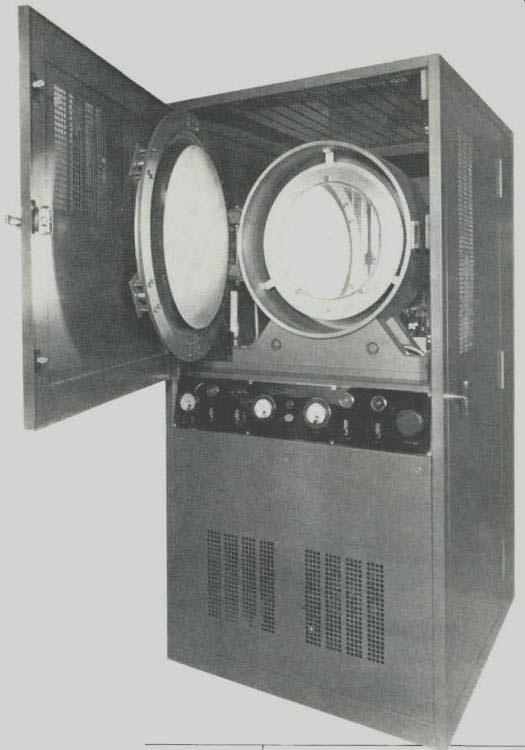
above: The gold-sputtering machine invented by Arthur Keller.
The Roxy Theater has long since been a victim of the wrecker's ball, but I under stand some of the recordings still exist, and perhaps some day Bell Labs will make it possible to hear them.
After the experiments with two-band concentric recording of both the split-frequency monophonic and the stereo variety, Arthur Keller invented a multiplex single-stylus recording system which permitted two or more channels of sound in a single groove. However, with the recorder-cutter of the time, there was not sufficient bandwidth to provide two channels of wide frequency range sound. Keller therefore decided to use a two-band system which used a vertical cut for one channel and a lateral cut for the other channel. One of the recorder-cutters was modified for this purpose to minimize cross-modulation between channels, and quite a number of stereo recordings were made during the early 1930s. (It is interesting to note that years later, in 1956, I met Arthur Haddy of Decca in New York and he demonstrated some similar vertical-lateral stereo recordings for me.) While these vertical-lateral stereo recordings had adequate separation between channels, Keller felt that distortion differences in the two channels were objectionable. To over come this and other problems, Keller and his colleague Ira Rafuse invented the 45/45 stereo recording system which is in current use. This plain statement of fact requires some explanation.
First of all, I am happy to note that Arthur Keller is still very much alive, quite hale and hearty in his 81st year. I have had the pleasure of meeting with him and discussing many aspects of his research at Bell Labs. In respect to the invention of the 45/45 stereo system, Keller notes that he and Rafuse had completed their work on this project in 1932 and had submitted patent applications through Bell Labs. For some reason, the patents were not filed until June of 1936, and eventually U.S. Patent #2,114,471 was issued to Keller and Rafuse on April 18, 1938. As is fairly common knowledge, Alan Blumlein of England is generally credited with the invention of the 45/45 stereo disc system in 1933. So who was first is a moot point, but in any case both parties invented essentially the same de vice. Several excerpts from the Keller Rafuse patent are pertinent to a general idea of the 45/45 stereo system:
"In accordance with the general features of the invention, the two recordings are formed by a single stylus which vibrates in two planes at an angle to each other and at equal angles to its own axis and to the surface of the record. In the preferred embodiment the planes of vibration are normal to each other and at 45 degrees to the surface of the record.
The recorder may consist of two suitable recorder units of any known type connected by suitable linkages to the common stylus, and the reproducer also preferably has two generating elements each responsive to undulations in only one of the groove walls so that the two records may be reproduced separately without using external networks.
"Since the recordings are disposed at the same angle to the record surface, quality differences may be substantially eliminated, and for this reason the invention is particularly useful in stereophonic reproducing systems.
"While the principal advantage of this invention over the combination hill-and dale/lateral system is its ability to give two reproductions of identical quality as required in certain applications such as stereophonic reproduction, the invention may be used in various other ways. For example, one of the recording units may be used to make a record in which the volume range is compressed and the other unit may cut a control record to effect a complementary expansion in the volume range during reproduction.
"Since the two recordings have vertical components in common, surface noise in reproduction can be materially reduced by cutting a sound record in only one of the recording planes and feeding back in reverse phase the output of the reproducer unit which is driven in the other plane into the circuit of the reproducer unit which is reproducing the recorded sounds." This rather astonishing proposed al ternate use of the 45/45 stereo system could have been the precursor of a present day disc noise-reduction system.
With the advances in disc-cutting technology at Bell Labs came the need for records with quieter surfaces. Thus, shellac records with their noisy built-in abrasives were abandoned. In the early 1930s clear cellulose acetate without abrasives was tried for records. The acetate proved to be considerably quieter than shellac, but it was a hygroscopic material and in conditions of high humidity absorbed moisture differentially and caused warpage. Bell Labs personnel determined that the usual processing of the wax masters contributed noise. The practice at the time was to make the wax electrically conductive by rubbing the surface with finely divided graphite. Fine as it was, there still was enough gross particulate graphite to cause noise.
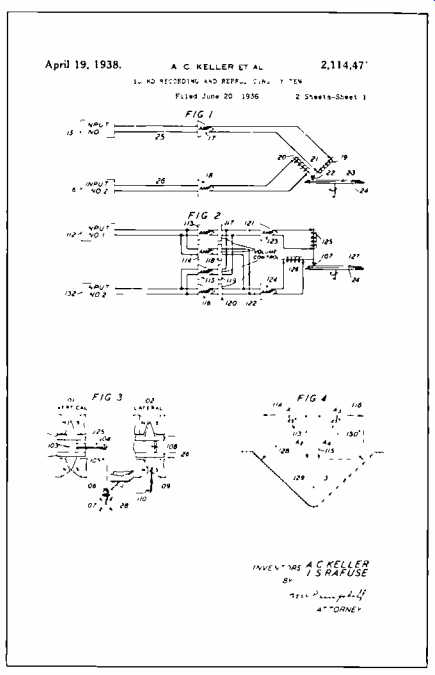
above: Schematic of the 45/45 stereo system patented by Arthur Keller
and Ira Rafuse.
Once again, it was Arthur Keller to the rescue with his invention of the gold-sputtering record-coating apparatus. There had been previous attempts at sputtering, but they were unsatisfactory. Keller's device was essentially a chamber in which a high vacuum could be created, a holder for the wax master, and a spiral grid of electrodes covered with gold. The electrodes were attached to a transformer which would step up the a.c. to a high voltage, and the spiral grid was placed approximately an inch above the wax master surface. The secret of Keller's success with this process was that when the high voltage was applied, the cathodic particles of gold were evenly deposited on the recorded wax surface because of the spiral configuration of the electrodes. In this manner, a molecular film of gold was plated on the wax master, and, in turn, the gold was heavily copper-plated by conventional electroplating. With this process at hand, Keller devised a new method of preparing wax masters. The standard practice was to use a cake of wax, approximately two inches thick, for recording the masters. If a mistake was made in recording, the modulated surface of the wax was "shaved" with an agate knife, thus presenting a new surface. This shaving did not produce a plane surface which was flat enough to suit Keller, so he made up metal plate molds with a 3-inch lip and into these he flowed wax to create a super-smooth surface. (In conversations, Keller told me the "wax" was a mixture of wax and several other compounds, more closely resembling a hard soap than a wax in the usual sense.) Once these wax masters had been gold-sputtered and copper-plated, live steam and caustic soda were used to remove the wax and clean the grooves, revealing the bright gold surface of the negative master. Bell Labs generally did not pro cess these discs any further, but used them directly to produce records. One day, representatives of Union Carbide showed up with a new plastic they called Vinylite and suggested it would be good for molding telephone instruments. It found immediate use in pure form to mold records, and at last, Bell Labs had their quiet records and were able to take advantage of the wide dynamic range possible with the new recording techniques.
Early in Bell Labs' effort to improve disc recording and reproduction, they decided to concentrate on vertical cut hill-and-dale records rather than lateral cut discs. The reasons for this are not hard to understand. In vertical cut records, the stylus is riding smoothly up and down (hill and dale) with the depth of the cut varying with the amplitude of the signal to be recorded. With this technique low-frequency, high-energy signals do not cause violent excursions of the stylus so that overcutting into adjacent grooves occurs as in the lateral cut records.
Groove pinch effect is considerably less of a problem, and there is less high-frequency inner-groove distortion. The vertical cut records of that period had a frequency range of 30 to 10,000 or 12,000 cycles and an amazing dynamic range of 60 dB, almost the same as the best of today's records! For optimum playback of the vertical cut records, Arthur Keller invented the moving-coil magnetic cartridge. The first embodiment was the 7A Reproducer with a diamond or sapphire stylus and which had an effective mass of less than 12.5 milligrams. Later on, the 9A Universal Phonograph Reproducer could play either vertical or lateral cut records, vertical-lateral stereo records with the requisite circuitry, or even 45/45 stereo re cords. Both of these moving-coil systems were said to track at less than 10 grams. Keller also described the "hair pin" moving-coil magnetic pickup which had but a single turn of wire on its coil, hence the "hairpin" designation. I re marked that the output of the cartridge must have been very low indeed, and he said that was no problem because his vacuum tube amplifier gave him "gain to burn." This hairpin cartridge could track at two grams, and it was able to play wax masters without damage so they could still be successfully processed into Vinylite records.
Among other inventions of Arthur Keller's which contributed greatly to the improvement of disc record quality was an "air advance ball," which used the Bernoulli principle. This replaced the old jewel advance ball which preceded the cutting stylus to adjust the depth of the cut. In so doing, the advance ball slightly scored the wax surface, enough to cause noise in the finished record. The air advance ball used low air pressure through a small tube terminated by a flange placed close to the cutting stylus.
The air pressure maintained about a 2-mil separation between the flange on the cutting head and the wax surface. Thus, depth of cut was accomplished without noise-producing damage to the wax surface.
With all of the elements for a high fidelity disc-recording and reproducing system on hand, Arthur Keller was ready for the historic collaboration between Leopold Stokowski and the Philadelphia Orchestra with Bell Labs.
It seems that early in 1930 Dr. Harvey Fletcher of Bell Labs approached Serge Koussevitsky, conductor of the Boston Symphony Orchestra, with the idea of enlisting his assistance in carrying out some experiments. Koussevitsky did not respond positively, and Fletcher subsequently approached Stokowski who gave him a favorable response.
Stokowski visited Bell Labs early in April 1930 to meet with Fletcher and other Bell Labs executives and was given demonstrations of some experimental work in progress. In a letter of April 8, 1931, Stokowski made an offer of help to Harold Arnold, one of the Directors of Bell Labs:
"If I or the Philadelphia Orchestra can be of any service to you in any sound experiments, we are always at your disposal. These experiments could be made during the rehearsals, so there would be no expense incurred whatever.
We never have anybody at the rehearsals so the experiments could be private and the results could be kept confidential if you so wish." Events moved rapidly after this overture. Within several months Bell Telephone Laboratories had established a room filled with electrical apparatus in the basement of Philadelphia's Academy of Music.
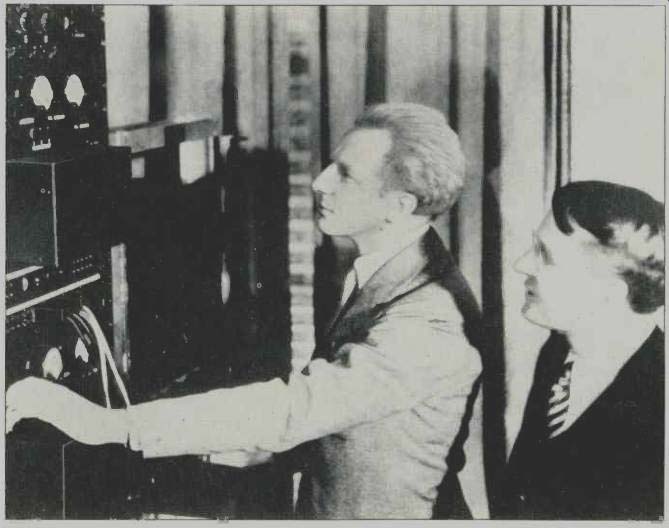
above: Leopold Stokowski (left) and Harvey Fletcher, then director
of physical research for Bell Labs, at Washington's Constitution Hall with
Stokowski adjusting the controls of early stereo equipment.
A memo from Dr. Arnold of Bell Labs in 1932 noted that, "Fortunately, through the friendly cooperation of Dr. Stokowski we were permitted to install our apparatus in the Academy of Music in Philadelphia, to place microphones as we pleased in the auditorium and use them both at rehearsals and at regular performances, and to make use of the large foyer in the Academy building for listening purposes." Thus Stokowski's April 1931 invitation dovetailed with Bell Labs' desire to make "proper evaluation of the frequency and dynamic ranges required in music reproduction." Bell Labs' interest in such tests was fourfold:
First, a desire to determine what changes, if any, should be made in the operating telephone companies' "pro gram circuits" carrying music from performance locations to radio broadcasting stations; second, speculation that "wire distribution circuits" to individual homes (shades of today's cable service!) might eventually prove a better alternative than radio for the transmission of high-quality music ("This is the strongly expressed opinion of Dr. Stokowski and some of his assistants, who feel that there is a vast difference in musical quality between that demonstrated in these experiments and the best they had ever heard by phonograph and radio"); third, interest in improving the sound quality in motion pictures, and fourth, desire to effect the improvement of records for home and broadcast use.
In the autumn of 1931 Arthur Keller and Ira Rafuse were at Philadelphia's Academy of Music to begin their historic recording sessions or, more properly, experiments. Keller had set up his recorder-cutter to make vertical-cut recordings and dual concentric stereo recordings. Strategically positioned in the Academy were two Bell Labs 618-A moving-coil microphones, and from what I can determine this mike was a precursor of the cardioid microphone. The 618-A apparently was essentially flat from 35 to beyond 10,000 cycles. I was a bit surprised that the famous 640-AA condenser calibration microphone was not used for these recordings, as it was a wider range mike than the 618-A. How ever, there may have been good reason for this since the 640-AA required the close proximity of its amplifier, and they may therefore have chosen the less obtrusive 618-A. I say this because Keller made experimental recordings of virtually the entire 1931-32 concert season, with the full cooperation of the Maestro, but unbeknownst to the orchestra members at Stokowski's request. Keller especially recalls a rehearsal on December 1, 1931, in which he asked Maestro Stokowski to play something he thought would demonstrate the widest frequency response and dynamic range capabilities of his orchestra. Stokowski responded with Berlioz' "Roman Carnival Over ture." Keller recalled that he "was sitting in the middle of the orchestra seats while Rafuse monitored the controls in the basement. After the magnificent 10-minute performance, I checked with Rafuse and he said, 'It looks like a good recording.' We came back to tell Stokowski, and he was completely exhausted, soaked with perspiration." In all, Arthur Keller made 128 recordings of the Philadelphia Orchestra. The flowed-wax master recordings were taken to Bell Labs and processed to gold-sputtered negatives, electroplated, and pressed on vinyl. Along with approximately 6,000 other gold-sputtered masters, these 128 recordings have been stored at Bell Labs in Murray Hill for 50 years. When it was decided to present some of these historic recordings to the Rodgers and Hammerstein Archives of Recorded Music at Lincoln Center in N.Y., experiments with pressing directly from the gold-sputtered masters were not too successful, mainly because of noise problems. Evidently, even with the permanency of gold, some deterioration had occurred. Apparently the flow characteristics of modern vinyl formulas, with their plasticizers, lubricants, etc., were not the same as the pure vinyl used in the old days. It must also be noted that these Philadelphia Orchestra recordings were never intended for commercial re lease, and therefore there are no complete recordings in the usual sense.
There are individual whole short works and "bits and pieces" of others. The Bell folks decided to play the gold-sputtered negatives with the Stanton special "saddle" stylus made for this purpose and to record the signals onto standard magnetic tape. In this way, some of the individual excerpts could be spliced together to create a continuous performance. The job of collating and assembling the music and making the disc-to-tape transfer was handled by H.
Ward Marsten IV of Philadelphia. From the edited tapes two records of the Stokowski/Philadelphia Orchestra performances have been made. The first volume has some stereo selections but is mainly vertical-cut monophonic. Included are the Berlioz "Roman Carnival Overture," Weber's "Invitation to the Dance," Mendelssohn's scherzo from "A Midsummer Night's Dream," the prelude and "Liebestod" from Wagner's "Tristan and Isolde," two excerpts from Scriabin's "Symphony #5, Prometheus: The Poem of Fire," and four excerpts from Moussorgsky's "Pictures at an Exhibition." The second volume is all Wagner with excerpts from the "Ring of the Nibelungen." Unfortunately, these two volumes of Stokowski and the Philadelphia Orchestra are not available to the general public. They were issued for historic and commemorative purposes, and in a ceremony at Lincoln Center in New York on January 16, 1980, Dr. William O. Baker, Chairman of the Board of Bell Labs, presented the two albums to David Hall, Curator of the Rodgers and Hammerstein Archives of Recorded Sound. Overall the performances on these discs are simply mind boggling! The virtuosity of the Philadelphia Orchestra at the height of its powers under the magic spell of Stokowski is just breathtaking. What in credible playing! What precision of ensemble! What ravishing tonalities! The sound is amazingly good. The records are a bit noisy, the first volume more so than the second. Frequency range is quite extended, and there is none of the thin pinched sound typical of standard records of that era. The stereo sound in both albums is quite good, with well-de fined left vs. right positioning and surprisingly little of the "hole in the middle" problem. Most impressive of all are the sonorities and really wide dynamic range in the Wagnerian excerpts on the second album. The first album presents the acoustics of the Academy of Music au nature!, a mite dry; the second album has a little reverb added which makes for a fuller sound. The recordings are a good reflection of the technical capabilities of Bell Labs and show what we might have had in the consumer record market if the Depression had not intervened.
Certainly, one must admire the talent shown, as well as the pioneering advances in recording technology that were the result of the work done at Bell Labs by men like Arthur Keller and his colleagues. A (Some of the quotes and material in this article are used with the kind permission of Robert McGinn of Stanford University and are excerpted from his talk "Stokowski and Bell Laboratories, Collaboration in the Development of High Fidelity Sound, 1930 to 1940," which was presented at the annual meeting of the History of Science Society in New York City, December 29, 1979.)
(adapted from Audio magazine, June 1981)
= = = =